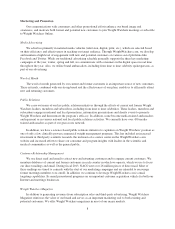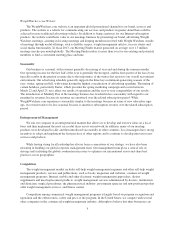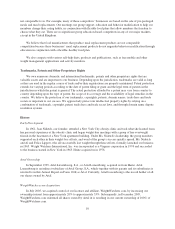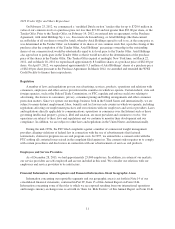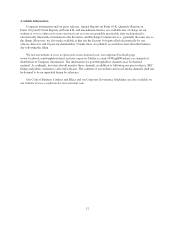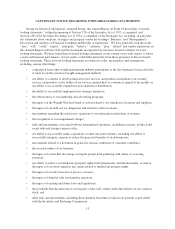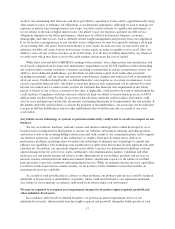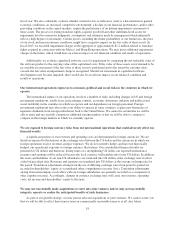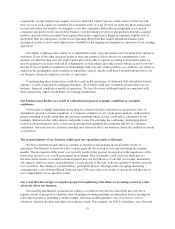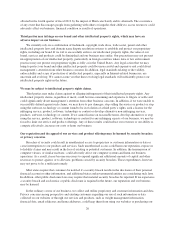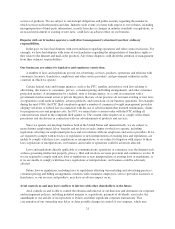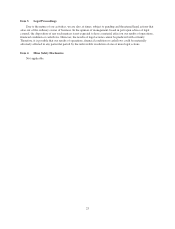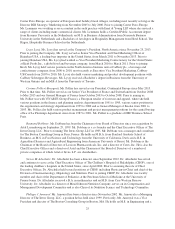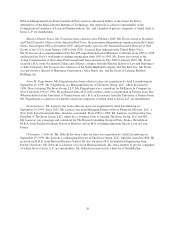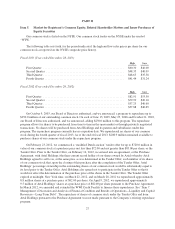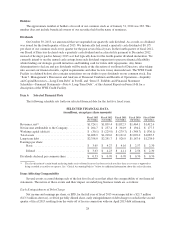WeightWatchers 2013 Annual Report Download - page 32
Download and view the complete annual report
Please find page 32 of the 2013 WeightWatchers annual report below. You can navigate through the pages in the report by either clicking on the pages listed below, or by using the keyword search tool below to find specific information within the annual report.fiscal year. We also continually evaluate whether current factors or indicators, such as a deterioration in general
economic conditions, an increased competitive environment, a decline in our financial performance, and/or other
prevailing conditions in the capital markets, require the performance of an interim impairment assessment of
those assets. The process of testing franchise rights acquired, goodwill and other indefinite-lived assets for
impairment involves numerous judgments, assumptions and estimates made by management which inherently
reflect a high degree of uncertainty. Certain factors, including the future profitability of our businesses, the price
of our stock and macroeconomic conditions, might have a negative impact on the fair value of these assets. In
fiscal 2013, we recorded impairment charges in the aggregate of approximately $1.2 million related to franchise
rights acquired in connection with our Mexico and Hong Kong operations. We may incur additional impairment
charges in the future, which would have an adverse impact on our financial condition and results of operations.
Additionally, we evaluate capitalized software costs for impairment by comparing the net realizable value of
the software product to the carrying value of the capitalized costs. If the value of those assets is not deemed to be
recoverable an assessment of the fair value of those assets is performed and to the extent the carrying value
exceeds the fair value an impairment charge is recognized. Should our investment in capitalized software
development costs become impaired, there would also be an adverse impact on our financial condition and
results of operations.
Our international operations expose us to economic, political and social risks in the countries in which we
operate.
The international nature of our operations involves a number of risks, including changes in US and foreign
government regulations, tariffs, taxes and exchange controls, economic downturns, inflation and political and
social instability in the countries in which we operate and our dependence on foreign personnel. Foreign
government regulations may also restrict our ability to operate in some countries, acquire new businesses or
repatriate dividends from foreign subsidiaries back to the United States. We cannot be certain that we will be
able to enter and successfully compete in additional foreign markets or that we will be able to continue to
compete in the foreign markets in which we currently operate.
We are exposed to foreign currency risks from our international operations that could adversely affect our
financial results.
A significant portion of our revenues and operating costs are denominated in foreign currencies. We are
therefore exposed to fluctuations in the exchange rates between the US dollar and the currencies in which our
foreign operations receive revenues and pay expenses. We do not currently hedge, and have not historically
hedged, our operational exposure to foreign currency fluctuations. Our consolidated financial results are
presented in US dollars and therefore, during times of a strengthening US dollar, our reported international
revenues and earnings will be reduced because the local currency will translate into fewer US dollars. In addition,
the assets and liabilities of our non-US subsidiaries are translated into US dollars at the exchange rates in effect
at the balance sheet date. Revenues and expenses are translated into US dollars at the average exchange rate for
the period. Translation adjustments arising from the use of differing exchange rates from period to period are
recorded in shareholders’ equity as accumulated other comprehensive income (loss). Translation adjustments
arising from intercompany receivables with our foreign subsidiaries are generally recorded as a component of
other expense (income). Accordingly, changes in currency exchange rates will cause our revenues, operating
costs, net income and shareholders’ equity to fluctuate.
We may not successfully make acquisitions or enter into joint ventures and we may not successfully
integrate, operate or realize the anticipated benefits of such businesses.
As part of our growth strategy, we may pursue selected acquisitions or joint ventures. We cannot assure you
that we will be able to effect these transactions on commercially reasonable terms or at all. Any future
18


